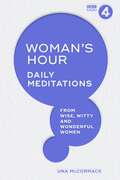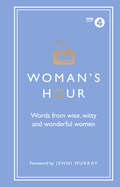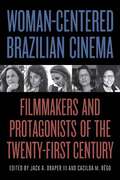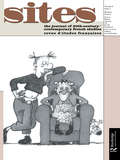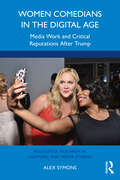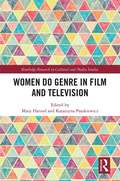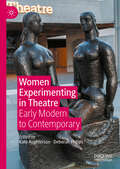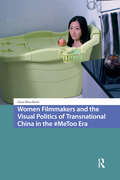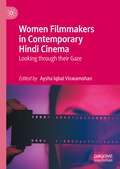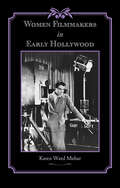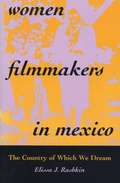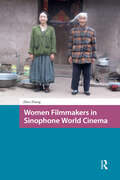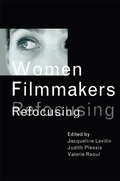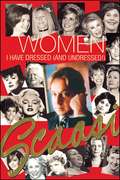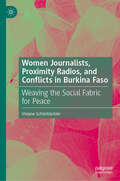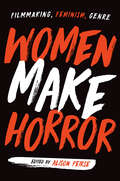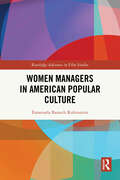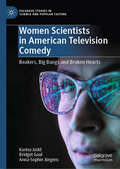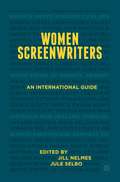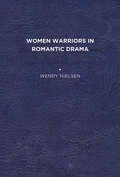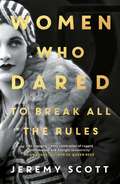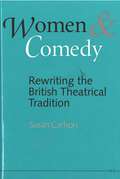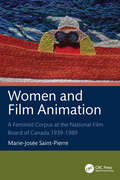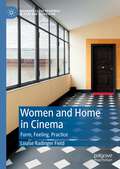- Table View
- List View
Woman's Hour: Daily Meditations from Wise, Witty and Wonderful Women
by Una McCormackFor 75 years, Woman’s Hour has brought us the most iconic and inspirational women from all over the world, delving into their lives and opinions, desires and lessons to others. Now, their wise words are brought to you each day in this daily guide.Woman’s Hour: Daily Meditations from Wise, Witty and Wonderful Women gives you a memorable quote to start your day, from a woman that has made us laugh, made us think and made us act, paired a thoughtful reflection on what that quote is teaching us. Featuring names such as Rosamund Pike, Jacqueline Wilson, Nina Simone, Annie Lennox, Mary Quant, Toni Morrison, Philippa Perry, Sandi Toksvig, Malala Yousafzai, Emma Thompson and many more, the topics range from the workplace to family, friendships to love, ageing to food, and just about everything in between.Start your day with the wisdom of these witty and wonderful women, from over 75 years of Woman’s Hour.
Woman's Hour: Words from Wise, Witty and Wonderful Women
by Alison MaloneyFor the last 70 years, the guests of Woman’s Hour have been entertaining listeners with their compelling combination of wit, warmth, insight and humour. Woman’s Hour has interviewed many of the biggest female names from entertainment, politics, the arts and beyond.Words from Wise, Witty and Wonderful Women is a collection of quotes and extracts from 70 years of the Woman’s Hour archive, featuring some of the most memorable guests to appear on the programme, from Doris Lessing to Nora Ephron, Hilary Clinton to J.K. Rowling, and Bette Davis to Meryl Streep. Charting the social and political revolution that has taken place in women’s lives over the past 70 years, as well as the perennial aspects of female life, such as love, family, relationships, the workplace, sex, ageing, and food, this delightful book shares fascinating insights and sage advice from the wise and wonderful women that have graced the Woman’s Hour airwaves over the decades.
Woman-Centered Brazilian Cinema: Filmmakers and Protagonists of the Twenty-First Century (SUNY series in Latin American Cinema)
by Jack A. Draper III Cacilda M. RêgoWoman-Centered Brazilian Cinema highlights the bold, inspiring, and diverse work of female filmmakers—including directors, screenwriters, and producers—and female protagonists in the twenty-first-century Brazilian film industry. This volume examines the diverse production and distribution spaces these filmmakers are working in, including documentary, experimental, and short filmmaking, as well as commercial feature films. An intersectional approach runs throughout the chapters with complex considerations around gender, race, sexuality, and class. The book features a mix of research methods and genres, with macro-level political, economic, and industry-wide views of gender disparities appearing alongside in-depth conversations with contemporary filmmakers Maria Augusta Ramos, Petra Costa, Mari Corrêa, and Paula Sacchetta, focused on micro-level personal experiences. In bringing together original essays and interviews, the volume provides valuable information for students of Brazil in general and of Brazilian film in particular.
Women
by Revue D’études FrançaisesPublished in 2001, Women is a valuable contribution to the field of Performance.
Women Comedians in the Digital Age: Media Work and Critical Reputations After Trump (Routledge Research in Cultural and Media Studies)
by Alex SymonsThis book offers a thorough examination of digital work by women comedians in the US, exploring their use of digital media to perform jokes, engage with fans, remake their reputations, and become political activists. This book argues that despite its many adverse effects, digital work is changing comedy, empowering women to create new comic forms and negotiate the contentious political climate incited by former President Donald. J. Trump. Chapters are focused on video podcasting, TikTok, Twitter, Instagram, YouTube, and the streaming platform Netflix – each containing informative case studies on significant women comedians who use them, including Sarah Silverman, Amy Schumer, Leslie Jones, Mindy Kaling, Colleen Ballinger, Lilly Singh, Ms. Pat, Whitney Cummings, Issa Rae, and others. To understand their strategies, this book examines the popularity of their digital content, their career outcomes in television and film, as well as the ups and downs of their critical reputations in magazines, newspapers, the trade press, and with their participatory audiences online. This insightful and timely work will appeal to scholars researching and teaching in the areas of media studies, digital communication, gender studies, and performance.
Women Do Genre in Film and Television (Routledge Research in Cultural and Media Studies)
by Katarzyna Paszkiewicz Mary HarrodThis volume examines how different generations of women work within the genericity of audio-visual storytelling not necessarily to ‘undo’ or ‘subvert’ popular formats, but also to draw on their generative force. Recent examples of filmmakers and creative practitioners within and outside Hollywood as well as women working in non-directing authorial roles remind us that women are in various ways authoring commercially and culturally impactful texts across a range of genres. Put simply, this volume asks: what do women who are creatively engaged with audio-visual industries do with genre and what does genre do with them? The contributors to the collection respond to this question from diverse perspectives and with different answers, spanning issues of direction, screenwriting, performance and audience address/reception.
Women Experimenting in Theatre: Early Modern to Contemporary
by Deborah Philips Kate AughtersonThis collection of essays, covering a broad historical range, shows that women working in theatre and drama since the time of Aphra Behn have been engaged in pushing the boundaries of conventional representation and dramaturgical convention. Collectively the authors show that women have used performing spaces as a channel for both political and personal radicalism - one that has demanded and celebrated experimentalism as a kind of survival in a male dominated world.
Women Filmmakers and the Visual Politics of Transnational China in the #MeToo Era (Critical Asian Cinemas)
by Gina MarchettiManoeuvring around mainland China’s censors and pushing back against threats of lawsuits, online harassment, and physical violence, #MeToo activists shed a particularly harsh light on the treatment of women in the cinema and entertainment industries. Focusing on films from the People’s Republic of China, Hong Kong, Taiwan, and the Chinese diaspora, this book considers how female directors shape Chinese visual politics through the depiction of the look, the stare, the leer, the glare, the glimpse, the glance, the queer and the oppositional gaze in fiction and documentary filmmaking. In the years leading up to and following in the wake of #MeToo, these cosmopolitan women filmmakers offer innovative angles on body image, reproduction, romance, family relations, gender identity, generational differences, female sexuality, sexual violence, sex work, labor migration, career options, minority experiences, media access, feminist activism and political rights within the rapidly changing Chinese cultural orbit.
Women Filmmakers in Contemporary Hindi Cinema: Looking through their Gaze
by Aysha Iqbal ViswamohanThis book is a comprehensive anthology comprising essays on women film directors, producers and screenwriters from Bollywood, or the popular Hindi film industry. It derives from the major theories of modernity, postmodern feminism, semiotics, cultural production, and gender performativity in globalized times. The collection transcends the traditional approaches of looking at films made by women filmmakers as ‘feminist’ cinema, and focuses on an extraordinary group of women filmmakers like Ashwini Iyer Tiwari, Bhavani Iyer, Farah Khan, Mira Nair Vijaya Mehta, and Zoya Akthar. The volume will be of interest to academics and theorists of gender and Hindi cinema, as well as anybody interested in contemporary Hindi films in their various manifestations.
Women Filmmakers in Early Hollywood (Studies in Industry and Society)
by Karen Ward MaharWomen Filmmakers in Early Hollywood explores when, how, and why women were accepted as filmmakers in the 1910s and why, by the 1920s, those opportunities had disappeared. In looking at the early film industry as an industry—a place of work—Mahar not only unravels the mystery of the disappearing female filmmaker but untangles the complicated relationship among gender, work culture, and business within modern industrial organizations.In the early 1910s, the film industry followed a theatrical model, fostering an egalitarian work culture in which everyone—male and female—helped behind the scenes in a variety of jobs. In this culture women thrived in powerful, creative roles, especially as writers, directors, and producers. By the end of that decade, however, mushrooming star salaries and skyrocketing movie budgets prompted the creation of the studio system. As the movie industry remade itself in the image of a modern American business, the masculinization of filmmaking took root.Mahar's study integrates feminist methodologies of examining the gendering of work with thorough historical scholarship of American industry and business culture. Tracing the transformation of the film industry into a legitimate "big business" of the 1920s, and explaining the fate of the female filmmaker during the silent era, Mahar demonstrates how industrial growth and change can unexpectedly open—and close—opportunities for women.
Women Filmmakers in Early Hollywood (Studies in Industry and Society)
by Karen Ward MaharA study of how and why women in early twentieth-century Hollywood went from having plenty of filmmaking opportunities to very few.Women Filmmakers in Early Hollywood explores when, how, and why women were accepted as filmmakers in the 1910s and why, by the 1920s, those opportunities had disappeared. In looking at the early film industry as an industry—a place of work—Mahar not only unravels the mystery of the disappearing female filmmaker but untangles the complicated relationship among gender, work culture, and business within modern industrial organizations. In the early 1910s, the film industry followed a theatrical model, fostering an egalitarian work culture in which everyone—male and female—helped behind the scenes in a variety of jobs. In this culture women thrived in powerful, creative roles, especially as writers, directors, and producers. By the end of that decade, however, mushrooming star salaries and skyrocketing movie budgets prompted the creation of the studio system. As the movie industry remade itself in the image of a modern American business, the masculinization of filmmaking took root. Mahar&’s study integrates feminist methodologies of examining the gendering of work with thorough historical scholarship of American industry and business culture. Tracing the transformation of the film industry into a legitimate &“big business&” of the 1920s, and explaining the fate of the female filmmaker during the silent era, Mahar demonstrates how industrial growth and change can unexpectedly open—and close—opportunities for women.&“With meticulous scholarship and fluid writing, Mahar tells the story of this golden era of female filmmaking . . . Women Filmmakers in Early Hollywood is not to be missed.&” —Samantha Barbas, Women&’s Review of Books&“Mahar views the business of making movies from the inside-out, focusing on questions about changing industrial models and work conventions. At her best, she shows how the industry&’s shifting business history impacted women&’s opportunities, recasting current understanding about the American film industry's development.&” —Hilary Hallett, Reviews in American History&“A scrupulously researched and argued analysis of how and why women made great professional and artistic gains in the U.S. film industry from 1906 to the mid-1920s and why they lost most of that ground until the late twentieth century.&” —Kathleen Feeley, Journal of American History&“Women Filmmakers in Early Hollywood offers convincing evidence of how economic forces shaped women&’s access to film production and presents a complex and engaging story of the women who took advantage of those opportunities.&” —Pennee Bender, Business History Review
Women Filmmakers in Mexico: The Country of Which We Dream
by Elissa J. RashkinWomen filmmakers in Mexico were rare until the 1980s and 1990s, when women began to direct feature films in unprecedented numbers. Their films have won acclaim at home and abroad, and the filmmakers have become key figures in contemporary Mexican cinema. In this book, Elissa Rashkin documents how and why women filmmakers have achieved these successes, as she explores how the women's movement, film studies programs, governmental film policy, and the transformation of the intellectual sector since the 1960s have all affected women's filmmaking in Mexico. <P><P> After a historical overview of Mexican women's filmmaking from the 1930s onward, Rashkin focuses on the work of five contemporary directors--Marisa Sistach, Busi Cortés, Guita Schyfter, María Novaro, and Dana Rotberg. Portraying the filmmakers as intellectuals participating in the public life of the nation, Rashkin examines how these directors have addressed questions of national identity through their films, replacing the patriarchal images and stereotypes of the classic Mexican cinema with feminist visions of a democratic and tolerant society.
Women Filmmakers in Sinophone World Cinema (Asian Visual Cultures)
by Zhen ZhangWomen Filmmakers in Sinophone World Cinema portrays a group of important contemporary women filmmakers working across the Sinophone world including Taiwan, Hong Kong, mainland China, and beyond. The book delineates and conceptualizes their cinematic and trans-media practices within an evolving, multifaceted feminist intimate-public commons. The films by these experienced and emerging filmmakers, including Huang Yu-shan, Yau Ching, Ai Xiaoming, Wen Hui, Huang Ji and others, represent some of the most innovative and socially engaged work in both fictional and non-fictional modes in Chinese-language cinema as well as global women’s cinema. Their narrative, documentary, and experimental film practices from the 1980s to the present, along with their work in sister media such as dance, theater, literature, and contemporary art, their activities as scholars, educators, activists, and film festival organizers or jurors, have significantly reshaped the landscape of Sinophone film culture and expanded the borders of world cinema.
Women Filmmakers: Refocusing
by Jacqueline Levitin Judith Plessis Valerie RaoulThis wide-ranging volume of new work brings together women filmmakers and critics who speak about what has changed over the past twenty years. Including such filmmakers as Margarethe von Trotta, Deepa Mehta, and Pratibha Parmar, and such critics as E. Ann Kaplan, this comprehensive volume addresses political, artistic, and economic questions vital
Women I Have Dressed (and Undressed!)
by Arnold ScaasiA premier American fashion designer shares his experiences with famous women from the past half century, describing how their personalities, preferences, and belief systems impacted his designs and the larger fashion arena.
Women Journalists, Proximity Radios and Conflicts in Burkina Faso: Weaving the Social Fabric for Peace
by Viviane SchönbächlerThis book explores the complex relationships between proximity radio and conflict in Burkina Faso from the perspective of female radio journalists. The study is based on in-depth qualitative field research, including interviews, audio diaries, and radio content analysis, using an analytical framework based on the concepts of participation and intersectionality. It provides a detailed account of radios in the northern provinces of Burkina Faso and the specificities of proximity radio in comparison to larger, national media outlets, particularly in their relationship with the community they serve. It also highlights the material and discursive consequences of violent conflict on radio stations, and shows how journalists regain agency despite severe constraints, as well as pointing to important - often invisible - contributions of women journalists in promoting peace and non-violent conflict transformation.
Women Make Horror: Filmmaking, Feminism, Genre
by Dahlia Schweitzer Alexandra Heller-Nicholas Martha Shearer Alison Peirse Katarzyna Paszkiewicz Tamar Jeffers McDonald Erin Harrington Janice Loreck Laura Mee Alicia Kozma Katia Houde Tosha R. Taylor Maddison McGillvray Molly Kim Donna McRae Lindsey Decker Valeria Villegas Lindvall Amy C. Chambers Sonia Lupher“But women were never out there making horror films, that’s why they are not written about – you can’t include what doesn’t exist.” “There are really, very few women horror filmmakers working today, that’s why so few are coming up.” “Women are just not that interested in making horror films.” “How can you be a woman and be a fan of horror?” This is what you get when you are a woman working in horror, whether as a writer, academic, festival programmer or filmmaker. These assumptions are based on decades of flawed scholarly, critical and industrial thinking about the genre. Women Make Horror sets right these misconceptions. Women have always been making horror, they have always been an audience for the genre, and today, as this book reveals, women academics, critics and filmmakers alike remain committed to a film genre that offers almost unlimited opportunities for exploring and deconstructing social and cultural constructions of gender, femininity, sexuality and the body. Women Make Horror is the first book-length study of women filmmakers in horror film, the first all-women edited book on horror film, and the first book to call out the male-bias in written histories of horror and then to illuminate precisely how, and where, these histories are lacking. It re-evaluates existing literature on the history of horror film, on women practitioners in the film industry and approaches to undertaking film industries research. It establishes new approaches for studying women practitioners and illuminates their unexamined contribution to the formation and evolution of the horror genre. The book focuses on women directors and screenwriters but also acknowledges the importance of women producers, editors and cinematographers. It explores narrative and experimental cinema, short, anthology and feature-filmmaking, and offers case studies of North American, Latin American, European, East Asian and Australian filmmakers, films and festivals. Women Make Horror is designed to not only engage and inspire dialogue between the academy, filmmakers, industry gatekeepers, festival programmers and horror film fans. With this book we can transform how we think about women filmmakers and genre.
Women Managers in American Popular Culture (Routledge Advances in Film Studies)
by Emanuela Barasch RubinsteinThis book explores various portrayals of women managers in American culture from the late 1960s to the present.An analysis of iconic films and works of fiction and nonfiction reveals how the image of the woman manager has evolved over time, reflecting shifting societal attitudes. In early depictions, she is an extreme outlier: her life revolves entirely around work, she rejects family life, and she is often hypersexualized. In the 1980s, a decade marked by the rise of feminist ideals, she emerged as a realistic character, grappling with challenges that still impact women in management today. Yet this progression was short-lived. At the close of the 20th century and into the early 21st century, chauvinistic tropes resurfaced, once again casting her in a negative light. Contemporary portrayals of the female executive position her as part of a rapidly shifting social landscape. She is but one element in an emerging social construct.The study of the woman manager is pertinent to the humanities and the social sciences, bridging these disciplines. This interdisciplinary volume will be of interest to scholars and students in cultural studies, gender studies, American studies, and cinema studies, as well as those in economics, management, and business schools.
Women Scientists in American Television Comedy: Beakers, Big Bangs and Broken Hearts (Palgrave Studies in Science and Popular Culture)
by Anna-Sophie Jürgens Karina Judd Bridget GaulThis book explores how women scientists are portrayed in hit American TV comedies The Big Bang Theory, Never Have I Ever, and Zoey’s Extraordinary Playlist using a science communication lens. The authors illuminate how comedy, especially irony and satire, communicate complex ideas about gender and science - both reflecting and challenging stereotypes about women in science. Perfect for fans of science, humor, media, and feminism, Women Scientists in American Television Comedy: Beakers, Big Bangs and Broken Hearts highlights the roles science communication, humor and pop culture play in shaping our understanding of women in STEM.
Women Screenwriters: An International Guide
by Jill Nelmes Jule SelboWomen Screenwriters is a study of more than 300 female writers from 60 nations, from the first film scenarios produced in 1986 to the present day. Divided into six sections by continent, the entries give an overview of the history of women screenwriters in each country, as well as individual biographies of its most influential.
Women Warriors in Romantic Drama
by Wendy C. NielsenWomen Warriors in Romantic Drama examines a recurring figure that appears in French, British, and German drama between 1789 and 1830: the woman warrior. The term itself, “woman warrior,” refers to quasi-historical female soldiers or assassins. Women have long contributed to military campaigns as canteen women. Camp followers ranged from local citizenry to spouses and prostitutes, and on occasion, women assisted men in combat. However, the woman warrior is a romantic figure, meaning a fanciful ideal, despite the reality of women’s participation in select scenes of the French Revolution and the Napoleonic Wars. The central claim of this book is the woman warrior is a way for some women writers (Olympe de Gouges, Christine Westphalen, Karoline von Günderrode, and Mary Robinson) to explore the case for extending citizenship to women. This project focuses primarily on theater for the reason that the stage simulates the public world that female dramatists and their warriors seek to inhabit. Novels and poetry clearly belong to the realm of fiction, but when audiences see women fighting onstage, they confront concrete visions of impossible women. I examine dramas in the context of their performance and production histories in order to answer why so many serious dramas featuring women warriors fail to find applause, or fail to be staged at all. Dramas about women warriors seem to sometimes contribute to the argument for female citizenship when they take the form of tragedy, because the deaths of female protagonists in such plays often provoke consideration about women’s place in society. Consequently, where we find women playing soldiers in various entertainment venues, farce and satire often seem to dominate, although this book points to some exceptions. Censorship and audience demand for comedies made producing tragedies difficult for female playwrights, who battled additional obstacles to fashioning their careers. I compare male (Edmund Eyre, Heinrich von Kleist) and female writers’ dramatizations of the woman warrior. This analysis shows that the difficult project of getting audiences to take women warriors seriously resembles women writers’ struggles to enter the ostensibly male domains of tragedy and the public sphere. Published by University of Delaware Press. Distributed worldwide by Rutgers University Press.
Women Who Dared: To Break All the Rules
by Jeremy ScottVictoria Woodhull, Mary Wollstonecraft, Aimee Semple McPherson, Edwina Mountbatten, Margaret Argyll and Chanel were all women who dared. They had no time for what society said they could and couldn&’t do and would see the world bend before they did. In 1872 a mesmerising psychic named Victoria Woodhull shattered tradition by running for the White House. Had she won the ensuing spectacle would surely have rivalled that of our own era. Abhorring such flamboyance, Mary Wollstonecraft inspired a revolution of thought with her pen as she issued women&’s first manifesto – still to be fulfilled. From Aimee Semple McPherson, the first female preacher in America, to Coco Chanel, designer of an empire, these women became the change they wanted to see in society. In Women Who Dared, Jeremy Scott pays tribute to them all with wit, verve and reverence.
Women and Comedy: Rewriting the British Theatrical Tradition
by Susan CarlsonThe first comprehensive study of its kind, this book explores the contradictory connections between women and dramatic comedy. Women and Comedy shows how a genre that has been used historically to restrict women's behavior is being reconfigured to express women's triumphs. It thus redefines the assumptions with which both traditional comedy and contemporary women's plays are read and viewed. Challenging a critical consensus that has seen comedy as a haven for female power, Carlson argues that traditional comedy is deeply sexist, welcoming strong women characters only because it can contain their power. Through an analysis of a range of comedies by Shakespeare, Congreve, Maugham, Shaw, and Ayckbourn, the author shows that even in these plays self-consciously about liberated females, women gain only a limited freedom, a freedom that the endings of the plays work to negate. This negotiation is seen to result in part from the comic structure itself, which privileges a merely temporary inversion and an ultimate return to the status quo. Carlson then examines the transitional work of three writers – Aphra Behn, Henry James, and Ann Jellicoe – whose heroines follow an unorthodox trajectory through their comic worlds. While the work of these writers clearly remains within the mainstream comic tradition, the author notes in them a subtle departure, most notably in their description of the heroine as subject rather than object, which prefigures the full-scale transformations of women in comedy by contemporary women writers. The book then examines contemporary comedy that revises traditional comic structure at the same time as it explores fundamental social change. In making her case for the difference of contemporary comedy by women, Carlson examines the reformulations of structure and character and considers issues of community, self, and sexuality in a broad range of plays by individual playwrights and by the new women's theater collectives. Women and Comedy is an important work for students of British drama and will appeal to theater practitioners, critics, feminist scholars, and all those interested in the performing arts.
Women and Film Animation: A Feminist Corpus at the National Film Board of Canada 1939-1989
by Marie-Josée Saint-PierreThe creations of female animation filmmakers are recognized all over the world while being, paradoxically, unknown to the general public. Women and Film Animation: A Feminist Corpus at the National Film Board of Canada 1939-1989 brings out of the shadows the work of true pioneers by presenting and analyzing, from a resolutely feminist perspective, the works they have conceived within the National Film Board of Canada (NFB).This institution has played an essential role in the emergence of animated cinema in Canada, but it is forgotten or ignored that a good part of this vast corpus is the work of women who have worked there not only as assistants but also as directors. These artists have contributed to changing the traditional representations of women in a unique way in both commercial and avant-garde animated cinema. The author accounts for their concerns, their creativity, and their many bright achievements. To do this, she relies on a wide range of critical works in social and cultural history of Canada, in feminist art history, and on multiple studies on animated cinema.Key Features: Provides an interdisciplinary approach that combines concepts from feminist studies, film theory and visual arts for a nuanced analysis of the role of women in animated cinema Discusses historical and sociological background that sheds light on the condition of women Includes a profound analysis of the changes and continuities in the role of women in this industry over time, focusing on the National Film Board of Canada Features previously unreleased archival material and selected excerpts from reviews by the NFB’s programming committee, highlighting the impact of production circumstances of the works of specific women animators
Women and Home in Cinema: Form, Feeling, Practice (Palgrave Close Readings in Film and Television)
by Louise Radinger FieldThis book explores visions of home in cinema and the ways in which women inhabit the onscreen realm. Looking closely at a range of films made between 1936 and 2013, it examines how filmmakers reconfigure studio sets and real locations through the filmmaking process into mutable onscreen domains imbued with depth, metaphor, and expressivity.The book studies the films through the lens of four filmmaking processes in particular: découpage, mise-en-scène, sound and editing. Close analysis reveals how filmmakers use these cinematic ‘building blocks’ to shape onscreen worlds charged with emotion and animated by the warp and weft of psychic life.Images of home abound in the cinema, and women frequently find themselves at the core of both structures. Drawing on recent spatial and feminist enquiry, the book reviews the idea of home as a fixed and stable location and illustrates how the art of cinema is well equipped to explore home as an imaginary as well as a material realm.With its emphasis on film practice as a route into critical reflection, this book will be of interest to filmmakers, film theorists and those who simply want to understand more about how films work.
